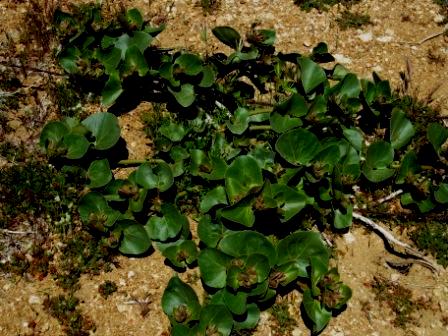On our hike to Horse Thief Creek, I found this plant nearly ready to bloom:

But I have no idea what it is! The area is about 3000 ft. in the Santa Rosa Wilderness. I’ve checked all the wildflower books I have for these deserts and am not having any luck. It doesn’t help that I can’t see the flowers, of course.
So take your best shots! I’ll check out all the guesses and come up with a list of best possibilities. Let’s see if you can help me learn a new plant.
I love a plant ID quiz! The foliage and thick stems remind me of a tropical morning glory I saw growing wild on a Mexican beach. The new growth points appear brown though which is not consistent with my guess. Are the flower buds brown or did the growth die back or…? Good luck!
Boy — my immediate thought was European Wild Ginger, which seems wildly unlikely (they are getting ready to bloom, but their buds live underneath the leaves, not above them). Are those brown bits the buds?
my first guess/glance was Galax – but that’s not native in your neck of the woods…
ps Hi Paul!
Miner’s lettuce? (Claytonia perfoliata)
The flower buds (the “brown bits”) are not damaged – this is their normal appearance. Perhaps we will have red flowers? I just don’t know. And Ruth, I thought this looked a lot like miner’s lettuce – but it’s gigantic! The plant is probably two feet across. (I should have looked at the leaves more closely so I could tell you if they were Claytonia-like.)
Unless it’s Australian I have noooooooooooooooooo chance of IDing it.
My (very) vague guess is possibly some kind of saltbush. I’ll have a stab at the Chenopodiaceae family, but that’s all I’ve got.
Mirabilis biglovii is my guess
We used to call it ‘Indian lettuce’ when we were kids. Don’t know what the proper name is though.
Looks a little like Ranunculus ficaria
A few questions for you Linda. Leaves hairy or glaucous? Leaves clasping or perfoliate? Do you think it could be past bloom? Is there anything your not telling us. Some little trick. Do you think it is native to the area? What was growing in the same location? Only questions and no answers. None of the suggestions seem to fit.
Mark, I should have taken more care in observation. I believe the flower buds were getting ready to open, though I could be wrong; the leaves were glaucous and appeared quite succulent; I did not take enough time to observe their attachment to the stem, unfortunately. I am starting to wonder if it is NOT native, since I’ve never seen it before and have been hiking in this region for a number of years. (But it was a very wet spring and I thought maybe that explained its appearance.) If anything, it reminded me of giant type of miner’s lettuce, but the leaves are wrong.
If you still have no luck, try either the Riverside-San Bernadino chapter of the California Native Plant Society or the San Diego chapters. Local chapter links can be found on the CNPS web site here:
http://www.cnps.org/cnps/chapters/map.php
Right now the Kern chapter is helping me identify a bright pink flowering 9′ bush that looks like a cross between an erica and a bottlebrush that was on bloom two weeks ago along I-5 between Castaic and Gorman between the 1,000 and 3,000 foot level. So far, very helpful. I recommend their organization.